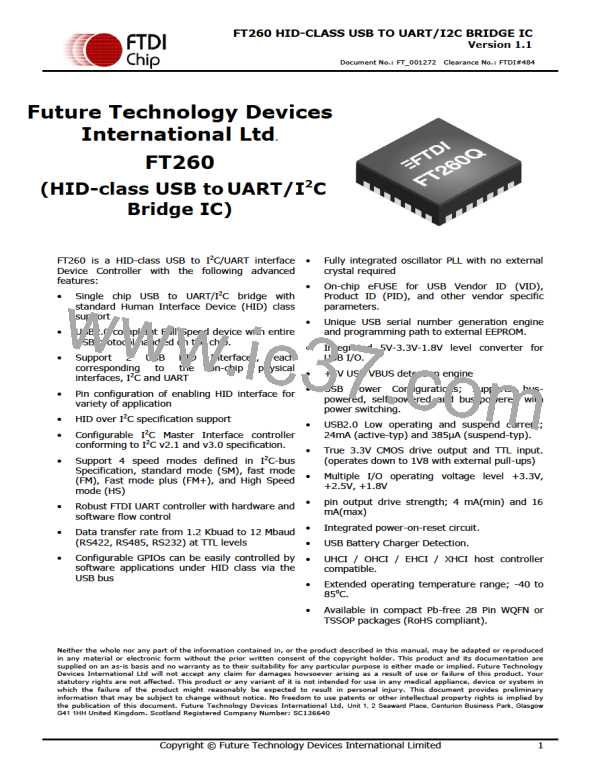FT260 HID-CLASS USB TO UART/I2C BRIDGE IC
Version 1.1
Document No.: FT_001272 Clearance No.: FTDI#484
generates 48MHz, 24MHz and 12MHz as reference clocks. The user can select one of these reference
clocks as the system operating clock through software over USB. The system operating clock will be the
clock source for embedded functions to generate the required interface clock. Higher frequencies should
be chosen for higher data throughput demand and lower frequencies for lower power operation. Users
can choose the system operating frequency based on the application.
USB Transceiver. The USB Transceiver cell provides the USB 1.1 / USB 2.0 full-speed physical interface.
Output drivers provide +3.3V level slew rate control , while a differential input and two single ended
input receivers provide data in, Single-Ended-0 (SE0) and USB reset detection conditions respectfully. A
1.5kΩ pull up resistor on USBDP is incorporated.
USB DPLL. The DPLL cell locks on to the incoming NRZI USB data and generates recovered clock and
data signals for the Serial Interface Engine (SIE) block.
Serial Interface Engine (SIE). The Serial Interface Engine (SIE) block performs the parallel to serial
and serial to parallel conversion of the USB data. In accordance with the USB 2.0 specification, it
performs bit stuffing/un-stuffing and CRC5/CRC16 generation. It also checks the CRC on the USB data
stream.
USB HID Protocol Engine. The USB HID Protocol Engine manages the standard commands from the
device control pipe when enumerating. It also handles the Human Interface Device (HID) class
commands between the standard HID host driver and the device with I2C or/and UART functions. With
the Device Interface Configuration pins, DCNF0 and DCNF1, it can easily connect HID functions via UART
or I2C interfaces to a PC host driver. Additionally, it can simultaneously support 2 HID functions via UART
and I2C interfaces. This Protocol Engine also includes an IN and OUT Buffer management memory unit
which handles the data between USB endpoints and function interfaces such as UART and I2C.
The USB HID Protocol Engine includes:
Endpoint-0 for a control pipe with max packet size 64 Bytes
2 endpoints for interrupt-in pipe with max packet size equal to 64 Bytes
2 endpoints for interrupt-out pipe with max packet size up to 64 Bytes
Multiple interfaces configuration support
HID class-specific request parsing and transporting to I2C/UART bus interface
command Suspend detection and power management
Remote wake-up support
Fully compatible to USB2.0 specification requirement in full speed mode
OUT Buffer. Data sent from the USB host controller to the FT260 via the USB data OUT endpoint is
stored in the OUT buffer. Data is removed from the OUT buffer to function interfaces under the control of
the USB HID protocol engines. The endpoint buffer size is 64 bytes as the maximum packet size defined
for full speed transferring. For the interrupt pipe, the buffer is double buffered for increased throughput.
IN Buffer. Data from the function interfaces is stored in the IN buffer. The USB host controller removes
data from the IN buffer by sending a USB request for data from the device data IN endpoint. The
endpoint buffer size is 64 bytes as the maximum packet size defined for full speed transferring. For the
interrupt pipe, the buffer is double buffered for increased throughput.
UART Controller. When the data and control bus are configured in UART mode, the interface
implements a standard asynchronous serial UART port with flow control. The UART performs
asynchronous 7/8 bit Parallel to Serial and Serial to Parallel conversion of the data on the RS232 (RS422
and RS485) interface. Control signals supported by the UART include RTS, CTS, DTR, DSR, DCD and RI.
Copyright © Future Technology Devices International Limited
14

 FTDI [ FUTURE TECHNOLOGY DEVICES INTERNATIONAL LTD. ]
FTDI [ FUTURE TECHNOLOGY DEVICES INTERNATIONAL LTD. ]